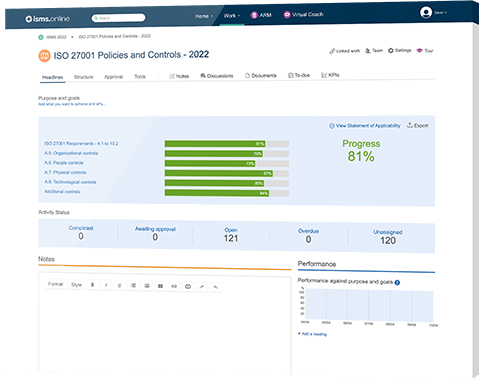
Authentication information such as passwords, encryption keys, and card chips are the gateway to information systems that host sensitive information assets.
Poor management or improper allocation of authentication information may result in unauthorised access to information systems and in loss of confidentiality, availability, and integrity of sensitive information assets.
For example, GoodFirm’s 2021 Research shows that 30% of all data breaches occur as a result of weak passwords or poor password management practices.
Therefore, organisations should have a robust authentication information management process in place to allocate, manage and protect authentication information.
Control 5.17 enables organisations to properly allocate and manage authentication information, eliminate risks of failure in the authentication process and prevent security risks that may arise due to compromise of authentication information.
Control 5.17 is a preventive type of control that requires organisations to establish and implement an appropriate authentication information management process.
| Control Type | Information Security Properties | Cybersecurity Concepts | Operational Capabilities | Security Domains |
|---|---|---|---|---|
| #Preventive | #Confidentiality #Integrity #Availability | #Protect | #Identity and Access Management | #Protection |
Considering that Control 5.17 entails establishment and implementation of organisation-wide rules, procedures, and measures for the allocation and management of authentication information, information security officers should be responsible for compliance with Control 5.17.
Organisations should comply with the following six requirements for allocation and management of authentication information:
Users who can access to and use authentication information should be instructed to comply with the following:
Organisations should comply with the following when establishing a password management system:
Furthermore, organisations should perform hashing and encryption techniques in accordance with the authorised cryptography methods for passwords as set out in Control 8.24.
In addition to passwords, there are other types of authentication information such as cryptographic keys, smart cards and biometric data such as fingerprints.
Organisations are advised to refer to ISO/IEC 24760 Series for more detailed guidance on authentication information.
Considering that frequent change of passwords might be cumbersome and annoying for users, organisations may consider implementing alternative methods such as single sign-on or password vaults. However, it should be noted that these alternative methods may expose authentication information to higher risk of unauthorised disclosure.

We’ll give you an 81% headstart
from the moment you log in
Book your demo
27002:2022/5.17 replaces 27002:2013/(9.2.4, 9.3.1 9.4.3)
Although the 2013 and the 2022 Version is highly similar in terms of the requirements for allocation and management of authentication information, the Control 5.17 in the 2022 Version introduces the following requirement, which was not included in the 2013 Version:
Control 5.17 introduces the following requirement for user responsibilities that was not referred to in Control 9.3.1 in the 2013 Version.
In contrast to the 2022 Version, Control 9.3.1 contained the following requirement for use of authentication information:
Control 9.4.3 in the 2013 Version included the following requirement for password management systems.
Control 5.17 in the 2022 version, on the contrary, did not contain this requirement.
ISMS.Online helps organisations and businesses meet the requirements of ISO 27002 by providing them with a platform that makes it easy to manage their confidentiality or non-disclosure policies and procedures, update them as needed, test them and monitor their effectiveness.
We provide a cloud-based platform for the management of Confidentiality and Information Security Management Systems, including non-disclosure clauses, risk management, policies, plans and procedures, in one central location. The platform is easy to use and has an intuitive interface that makes it simple to learn how to use.
Contact us today to schedule a demo.
| ISO/IEC 27002:2022 Control Identifier | ISO/IEC 27002:2013 Control Identifier | Control Name |
|---|---|---|
| 5.7 | New | Threat intelligence |
| 5.23 | New | Information security for use of cloud services |
| 5.30 | New | ICT readiness for business continuity |
| 7.4 | New | Physical security monitoring |
| 8.9 | New | Configuration management |
| 8.10 | New | Information deletion |
| 8.11 | New | Data masking |
| 8.12 | New | Data leakage prevention |
| 8.16 | New | Monitoring activities |
| 8.23 | New | Web filtering |
| 8.28 | New | Secure coding |
| ISO/IEC 27002:2022 Control Identifier | ISO/IEC 27002:2013 Control Identifier | Control Name |
|---|---|---|
| 6.1 | 07.1.1 | Screening |
| 6.2 | 07.1.2 | Terms and conditions of employment |
| 6.3 | 07.2.2 | Information security awareness, education and training |
| 6.4 | 07.2.3 | Disciplinary process |
| 6.5 | 07.3.1 | Responsibilities after termination or change of employment |
| 6.6 | 13.2.4 | Confidentiality or non-disclosure agreements |
| 6.7 | 06.2.2 | Remote working |
| 6.8 | 16.1.2, 16.1.3 | Information security event reporting |
| ISO/IEC 27002:2022 Control Identifier | ISO/IEC 27002:2013 Control Identifier | Control Name |
|---|---|---|
| 7.1 | 11.1.1 | Physical security perimeters |
| 7.2 | 11.1.2, 11.1.6 | Physical entry |
| 7.3 | 11.1.3 | Securing offices, rooms and facilities |
| 7.4 | New | Physical security monitoring |
| 7.5 | 11.1.4 | Protecting against physical and environmental threats |
| 7.6 | 11.1.5 | Working in secure areas |
| 7.7 | 11.2.9 | Clear desk and clear screen |
| 7.8 | 11.2.1 | Equipment siting and protection |
| 7.9 | 11.2.6 | Security of assets off-premises |
| 7.10 | 08.3.1, 08.3.2, 08.3.3, 11.2.5 | Storage media |
| 7.11 | 11.2.2 | Supporting utilities |
| 7.12 | 11.2.3 | Cabling security |
| 7.13 | 11.2.4 | Equipment maintenance |
| 7.14 | 11.2.7 | Secure disposal or re-use of equipment |